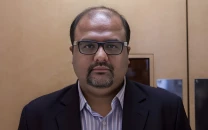Hazardous element: Dental hospitals have 20 times higher indoor mercury levels than permissible limit
SDPI report says that lives of medical staff at constant risk.

Resolution calls for effective measures to reduce and eliminate mercury use. PHOTO: FILE
The indoor levels of mercury at some dental hospitals in the twin cities are up to 20 times higher than the permissible limit, putting the lives of medical staff at risk.
This was a finding, among others, of an ongoing study that is being conducted by the Sustainable Development Policy Institute (SDPI).
The institute monitored the mercury levels inside around 15 medical sites including private clinics, general hospitals, teaching hospitals and colleges in Rawalpindi and Islamabad.
The names of the sites were not released due to a confidentiality agreement between the SDPI and the medical sites.
The study is being conducted in collaboration with the European Environmental Bureau (EEB) and the Zero Mercury Working Group (ZMWG) in various cities of Pakistan to assess air quality.
Mercury is a heavy metal which poses serious risks to the environment and human health. It is found, among other things, in amalgam dental fillings, thermometers and electric bulbs.
The study’s results show an alarming situation, said Dr Mahmood A Khwaja, a senior adviser at the SDPI.
The level of mercury pollutants in the indoor air at some dental hospitals was eight to 20 times higher than the permissible limit of 2,000 nanograms per cubic meter. A nanogram is one-billionth of a gram.

Khwaja said that the greatest risk from the elevated mercury levels is to the health of medical and paramedical staff.
“The patients are usually only present for an hour or two in these wards, but the medical staff works there day in, day out,” he said.
The situation is the worst in teaching hospitals and medical practices are partly to be blamed for the high mercury levels.
Khwaja said that the bachelor in dental surgery requires students to perform at least 30 dental filling procedures. Since the mercury amalgam is inexpensive, teaching hospitals mostly use mercury instead of other safer alternatives.
“There are usually 30 to 40 students performing these fillings in close quarters where there isn’t even proper cross ventilation,” Khwaja said.
He said that some of the medical staff poured mercury for the fillings “as if they were pouring sugar in their tea”
But he said some of the dental hospitals and clinics have responded positively to the results of the ongoing SDPI study and assured immediate precautionary measures. Such measures include improving cross-ventilation, exhaust fans, reduction of mercury use and treatment of waste at dental institutions.
Outdoor air at the testing sites showed lower level of mercury compared to indoor air. A comprehensive report would be prepared at the end of the study, which would also be used to raise awareness in public on toxicity and health hazards of exposure to mercury.
Published in The Express Tribune, April 11th, 2013.

















COMMENTS
Comments are moderated and generally will be posted if they are on-topic and not abusive.
For more information, please see our Comments FAQ